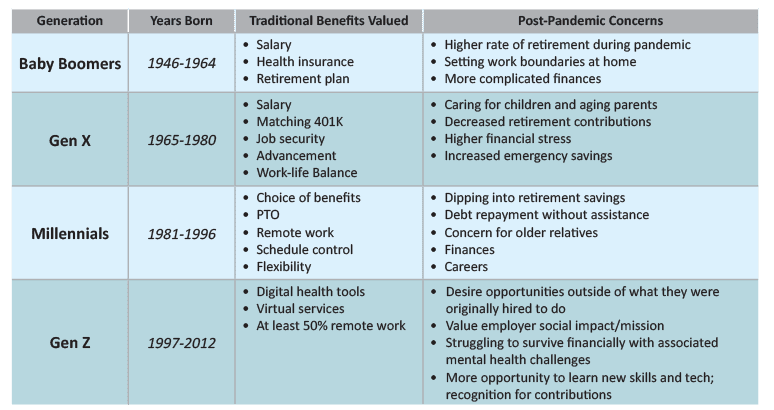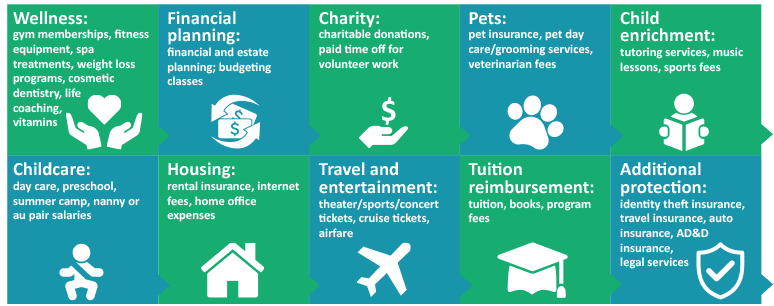
The COVID-19 pandemic has affected virtually every aspect of our lives. While the most prominent impact was an almost immediate quarantine and vast expansion of employees working from home, another significant consequence is how much the pandemic shook employees’ sense of security. Many businesses faced major revenue shortfalls and responded with cost-cutting measures, including layoffs and furloughs. Consequently, many Americans lost their sense of security regarding their jobs, economic standing, and overall health. As we focus on benefit strategies in a post-pandemic world recovering from the economic fallout, employers have an opportunity to bolster their employees’ overall sense of security, stability, and well-being.
Impacts of the Pandemic on the Workforce
Employer-sponsored benefits come in many different forms. Most commonly, benefit packages include health and life insurance coverage, paid time off, health benefit accounts, and retirement plans. But in a post-pandemic world where employees are struggling to balance competing demands, employers must be more creative with their strategies, including remote work options, flexible schedules, well-being programs, and other work-life management support.

What do employees look like across age groups in a post-pandemic world?
The U.S. workforce is comprised of four generational cohorts: Baby Boomers, Gen X’ers, Millennials and Gen Z’ers. Each group has lived through different challenges, but one thing they all have in common is that the pandemic has shifted their thinking regarding work and their personal lives. As a result, views have shifted as to which employee benefits are most valuable.

Let’s look at these groups a little deeper to better understand their needs and concerns.

Baby Boomers – Born into a post-war environment, this generation has survived additional wars, social change, political upheaval and more. But the pandemic caused them to really examine their current life stage and consider retiring early. As a result, retirements were 50% higher in 2020 than in any other year over the last decade. For Baby Boomers who remain in the workforce, 71% consider physical healthcare and vision care as must-haves. From a well-being perspective, their priorities include staying within budget, growing retirement income and wealth, eating healthy, getting regular screenings, managing health conditions, and balancing work and personal commitments.

Gen X – This group feels the pull of competing responsibilities perhaps moreso than the others. In addition to caring for their own children, many also care for parents. The pandemic has not changed their traditional benefit preferences much, though they have grown more concerned with emergency savings and caregiving benefits. This is likely in response to the financial and mental strain they feel while caring for others. Because of the pandemic, Gen X’ers reduced retirement contributions by 11%, while some (25%) have increased emergency savings. Sixty-five percent report being stressed about their financial security. From a well-being perspective, their priorities include staying within budget, growing retirement income and wealth, eating healthy, balancing work and personal commitments, and building an emergency fund.

Millennials – This generation is facing a significant financial challenge and are more stressed about debt than Baby Boomers or Gen X. Many of them have accumulated more debt than prior generations and almost half (40%) believe they will need assistance to pay it off. However, they also value well-being benefits more than older generations and are 3-5 times more likely than their elders to use these types of programs. Their top well-being priorities include eating healthy, balancing work and personal commitments, exercising, reducing and managing stress, staying within budget, and growing relationships.

Gen Z – Due to the economic challenges as this group entered the job market, they have suffered from financial and career-related disruptions. Due in part to cancelled internships and entry-level positions, plus layoffs and furloughs, about a third are struggling with mental health issues. They prefer in-person training, want managers to check in on them periodically, and need recognition for their contributions. From a well-being perspective, they prioritize stress management, eating healthy, balancing work and personal commitments, gaining additional job skills, advancing their career positions, and staying within budget.
With such a variety of personalities and priorities, how do employers adapt?
A significant disruption such as the pandemic presents an opportunity for employers to revisit the social contract they have with employees to help them regain economic security and well-being. The one thing that all generations share is that the pandemic made them feel unsettled, unsafe, and often, physically or mentally unwell. To attract and maintain a productive and efficient workforce, employers must take a greater role in helping employees to achieve security, protection, and well-being. Employers need to look at more creative ways of helping employees to attain these goals.
While traditional insurance coverages provide some protection from medical-related financial struggles, the workforce is demanding more. Employers will need to start considering a wider range of creative benefit options. Studies show that employees are thinking about their current work situation and reviewing options to improve their overall sense of well-being. For example:
- 79% of employees want their benefits package expanded and to focus more on their well-being
- 70% want flexible remote work options to continue
- An overwhelming majority of employees believe that resilient workers who feel secure in their personal lives are more productive (90%) and more engaged (91%)
- When employees say they understand their employer’s benefits communications and are satisfied with the frequency and clarity of those communications, they indicate a 156% increase in feeling valued and appreciated
All age groups in the workforce have expressed similar areas of well-being that they feel employers should support. All are also concerned with staying within their budgets. This could be accomplished through employer-sponsored financial planning assistance or budgeting classes. All have also expressed an interest in managing or reducing stress. Employers could set aside funds for gym memberships or fitness programs, or hold on-site classes for yoga or meditation. Another priority supported by all generations is eating healthy. Employers could sponsor healthy cooking classes or provide regular recipe suggestions to inspire employees to eat better.
For brokers and TPAs who support employers, what do these changes mean?
Gone are the days when employers could just buy a medical/dental/vision plan, start a 401K, “set it and forget it,” and expect employees to be happy. With the rising demand for more benefits and more creative options, businesses may feel like they are drowning and don’t know where to turn. This is where brokers and third-party administrators (TPAs) come in. Brokers and TPAs can help employers find and select plans in addition to identifying creative benefit options. They can help enroll participants, maintain and administer benefits, and communicate with participants on a regular basis. Further, the communication channels and messaging need to change to adapt to how each employee group absorbs information. All of this makes for a busy job and it’s one that many employers will want to contract out.
Where brokers and TPAs have become accustomed to recommending a smaller portfolio of benefits, it’s up to them now to seek out the creative options that will help businesses expand their benefit options to retain and attract the best talent possible. In fact, if brokers and TPAs aren’t already doing so, they need to consider flexible benefit options such as:
- Employee Assistance Programs that go beyond what is offered by the health plan, with a greater focus on physical and mental telehealth.
- Student Loan Repayment Assistance, needed by 27% of all employees, a quarter of which say that their level of student loan debt is ruining their quality of life. Fortunately, under the CARES Act and Consolidated Appropriations Act, student loan repayment assistance from employers is non-taxable up to $5,250 annually per employee through December 2025.
- Emergency Savings Accounts to help employees rebuild a sense of financial security by assisting them in building an emergency fund through automatic payroll deductions. Sadly, 40% of U.S. households would struggle to cover a $400 emergency expense, so this benefit could go a long way toward alleviating a major worry – at no cost to the employer beyond administrative expense.
- Lifestyle Spending Accounts provide some of the most flexible benefit options in the market today. While they are a post-tax benefit, they are employer-funded and can be designed to fit overall organizational values, meet specific employee needs, and fill in gaps in an overall benefits program. More importantly, they can help attract new employees and improve retention.
Common Types of LSAs

Conclusion: How the Pandemic Has Impacted Employee Benefit Strategies
The COVID-19 pandemic has not just haunted Americans in a number of ways and cost lives and dollars, it has created a major paradigm shift in the way we live and work. Whether we retired early to reduce exposure to the virus, or our personal workloads doubled or even tripled due to homeschooling or caring for other family members, we’ve all suffered. This paradigm shift has especially changed employee well-being priorities to focus more on security, health, families, and relationships. In response, employers must become more patient and mindful of the needs of their employees, all while continuing to determine how to successfully operate their businesses amidst a pandemic and, ultimately, in a post-pandemic world.
Employers and employees should strive to take better care of each other, while TPAs and brokers need to focus on taking special care of both. The effects of the pandemic on the business environment may be short-term, long-term, or permanent, so we must all prepare and plan accordingly.
If employers don’t already have a TPA partnership in place, they should seek one out today to help them better care for their employees. And TPAs need to ensure that they have the technology and operations infrastructure in place to administer more flexible and creative benefit options now and in the future.
References
- 2021 Employee Well-being Mindset Study, Alight Solutions, Kantar, and the Business Group on Health, 2021
- 2021 Tax-Efficient Retirement Income Survey, Nationwide Retirement Institute and The Harris Poll, March 2021
- Before the Coronavirus, Telework Was An Optional Benefit, Pew Research Center, March 20, 2020
- Invest in Parents Now, Cleo.com, August 2021
- EBRI/Greenwald Research Workplace Wellness Survey 2020, EBRI/Greenwald Research, 2021
- EBRI: Most Families Have Little Emergency Savings, American Society of Pension Professionals and Actuaries, August 13, 2021
- Glassdoor Economic Research: Workplace Trends 2021, Glassdoor.com, November 19, 2020
- MetLife’s 19th Annual U.S. Employee Benefit Trends Study 2021, Metropolitan Life Insurance Company, and Rainmakers CSI, 2021
- Millennials’ Mental Health is On The Decline and COVID-19 is Making It Worse, Fierce Healthcare, October 16, 2020
- Nine Things Gen Z’ers Want Post-Pandemic, Psychology Today, July 12, 2021
- Most Americans Say Coronavirus Outbreak Has Impacted Their Lives, Pew Research Center, March 30, 2020
- Publication 15-B (2021), Employer’s Tax Guide to Fringe Benefits, Internal Revenue Service, 2021
- The New Shape of Work is Flexibility for All, Mercer LLC, 2021
- Responding to Permanent Pandemic Changes in the Workplace, Forrester Research and Bswift, June 17, 2021
- The Implications of COVID-19 for Mental Health and Substance Use, Kaiser Family Foundation, February 10, 2021
- The Pandemic is Changing Employee Benefits, Harvard Business Review, April 7, 2021
- There’s No Growth Without Health: Employee Well-being is Non-Negotiable, Forbes, July 24, 2021
- Women in the Workplace Study, LeanIn and McKinsey & Company, 2020
- Work Trend Index: The Next Great Disruption is Hybrid Work, Microsoft, March 22, 2021
About the Company:
For 40 years, DataPath has been a pivotal force in the employee benefits, financial services, and insurance industries. The company’s flagship DataPath Summit platform offers an integrated solution for managing CDH, HSA, Well-Being, COBRA, and Billing. Through its partnership with Accelergent Growth Solutions, DataPath also offers expert BPO services, automation, outsourced customer service, and award-winning marketing services.
